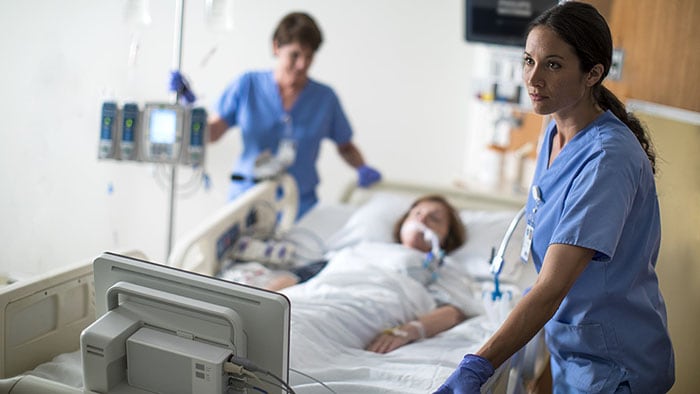Transformation: It’s the implementation that matters
At Philips, we believe that the success or failure of transformation is determined by not only the quality of the strategic transformation concept itself, but how the concept is executed. That is why we pay special attention to the implementation process. What makes our consulting service unique is that we offer a helping hand to our clients during the operational phase."
In the age of digitalization, it is now more important than ever for hospitals to be capable of transformation in order to remain competitive. However, it is estimated that nearly two-thirds of all transformation projects fail. At Philips, we believe that the success or failure of transformation is determined by not only the quality of the strategic transformation concept itself, but how the concept is executed. That is why we pay special attention to the implementation process. What makes our consulting service unique is that we offer help to our clients during the operational phase. As solution providers, we offer long-term support to hospitals by working collaboratively to optimize processes in the areas of quality of care and economic efficiency and to improve patient experience and staff satisfaction. For us, this also involves taking time to define key performance indicators with the client and assuming responsibility for achieving those goals. Analysis: As concise as possible Performance indicators enable an objective comparison of the current and desired state. During transformation projects, it is common to invest a lot of time and energy into analyzing the current state. At Philips, we do this differently by keeping the current state assessment as concise as possible. Once we have identified the areas for improvement and their causes, we jump straight into the prototyping. During this phase, hospital staff work together with experts in our HealthSuite Labs to develop initial solutions and assess their feasibility. Interdisciplinary teams are a crucial factor here, as the design thinking methodology we use is based on embracing different perspectives. It brings together people from different departments, professions, and hierarchy levels so that they can be creative together in a safe space. The more diverse the teams, the greater the potential for innovative ideas. Change cannot be achieved using a top-down approach only Transformation processes always present a particular challenge that can initially cause a feeling of uncertainty. Some people react with an "I can't be bothered" mentality or even refusal, while others withdraw. No one yells, "Yippee, everything is going to change now!" That is why real change doesn't just happen from the top down. To establish acceptance and motivation, there must an awareness of why the change is necessary. Just as important is the involvement of stakeholders early in the process. At Philips, we involve staff in every stage of the project so they play an active role in shaping the transformation. Our CoCreate approach is particularly valuable here. For example, our customers appreciate how we succeed in creating a constructive dynamic, as well as a mutual understanding between the various professional groups, such as doctors, nursing staff and management.
Real change doesn't just happen from the top down. We involve employees at every stage of the project so they play an active role in shaping the transformation."
Creating transparency with digital tools Even promising projects can come to a halt if the effort to implement them is disproportionate to the tangible benefit gained, or if there are simply no means to give quantitative feedback. This is one area in which use of the appropriate digital tools can help. Philips offers a full range of digital tools to make processes trackable and therefore measurable. It allows assessment of the current situation at any time, showing which efforts are effective and which still need fine-tuning. For example, PerformanceFlow can help optimize workflows in the emergency room. This platform-based solution allows real-time tracking of important resources such as mobile equipment and makes it possible to analyze this movement data. PerformanceBridge provides detailed insights into the performance of imaging systems and enables, among others, the analysis of device utilization, examination times and waiting times. IntelliVue Guardian, an automated early warning system supporting nursing staff on the general ward, detects early deterioration in a patient's condition. This helps reduce the number of cardiac arrests and unplanned transfers to intensive care. Diversity is key in the consulting team Process optimization is a universal vehicle for increasing quality and efficiency in hospitals. The projects that Philips implements in radiology, cardiology, intensive care or the operating room are therefore diverse. This diversity is also reflected in the Philips consulting team. As a global company we have a range of competencies, which we bundle together with our CoCreate approach. Next to technical expertise, we bring in-depth knowledge and experience in lean and change management. After all, at Philips we are also in the midst of continuous transformation. Our consulting team also includes representatives from hospital management and finance, as well as specialists and nurses who have first-hand knowledge of everyday care. Additionally, we have an international design organization focused on healthcare. This enables us to include a wide variety of perspectives in our consulting projects. We are ideally positioned to understand the special challenges of healthcare providers and to actively support them in their transformation projects. For Philips, consulting is more than just creating concepts. We work collaboratively with on-site teams to find solutions and ensure their implementation.
About the author

Dr. Patrick Heiler Principal Consultant, DACH region
Patrick and his team develop and deliver strategic consulting offerings to hospitals and healthcare providers to help optimize clinical outcomes while reducing costs and improving efficiency across their clinical and business processes. As researcher, Patrick has published in several scientific journals in the field of innovative imaging techniques and analysis methods.
You are about to visit a Philips global content page
Continue

